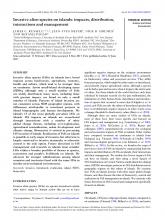LA VALORISATION SOCIO-ÉCONOMIQUE DES ESPÈCES EXOTIQUES ENVAHISSANTES établies en milieux naturels : un moyen de régulation adapté ? Première analyse et identification de points de vigilance

BRB
Available Online
Des invasions biologiques aux conséquences multiples: Les espèces exotiques envahissantes (EEE dans la suite de louvrage) constituent lune des principales pressions sur la biodiversité à léchelle mondiale, au même titre que la destruction des habitats naturels, la surexploitation des ressources, les pollutions ou le changement climatique. Les espèces introduites, lorsquelles se révèlent envahis¬santes, provoquent des impacts multiples, directs ou indi¬rects, affectant les espèces indigènes, les habitats naturels et les services rendus par les écosystèmes, mais égale¬ment les activités économiques et la santé humaine. Partout dans le monde, à des échelles géographiques et des intensités très variables, les EEE provoquent des altérations du fonctionnement des écosystèmes et causent la régres¬sion despèces indigènes. Selon les dernières estimations de la Liste rouge des espèces menacées de lUICN, elles constituent une menace pour près dun tiers des espèces terrestres menacées de disparition et sont impliquées dans la moitié des extinctions connues (UICN France, 2015). Sur le plan économique, les conséquences négatives des invasions biologiques peuvent être très importantes (Ket¬tunen et al., 2009). Les impacts qui génèrent des coûts économiques pour divers acteurs ou la société dune manière générale sont multiples : dépréciation des rende¬ments agricoles, coûts sanitaires, coûts de régulation des invasions de ces espèces sur le terrain, coûts de restaura¬tion des milieux naturels envahis et, de manière plus diffi¬cilement quantifiable, les impacts sur les services rendus par les écosystèmes. Sur le plan sanitaire, de nombreuses espèces introduites constituent de plus une menace pour la faune et la flore ou pour la santé humaine. Elles peuvent être allergènes, pa¬thogènes ou toxiques, ou encore constituer des réservoirs ou des vecteurs de micro-organismes et virus pathogènes.

